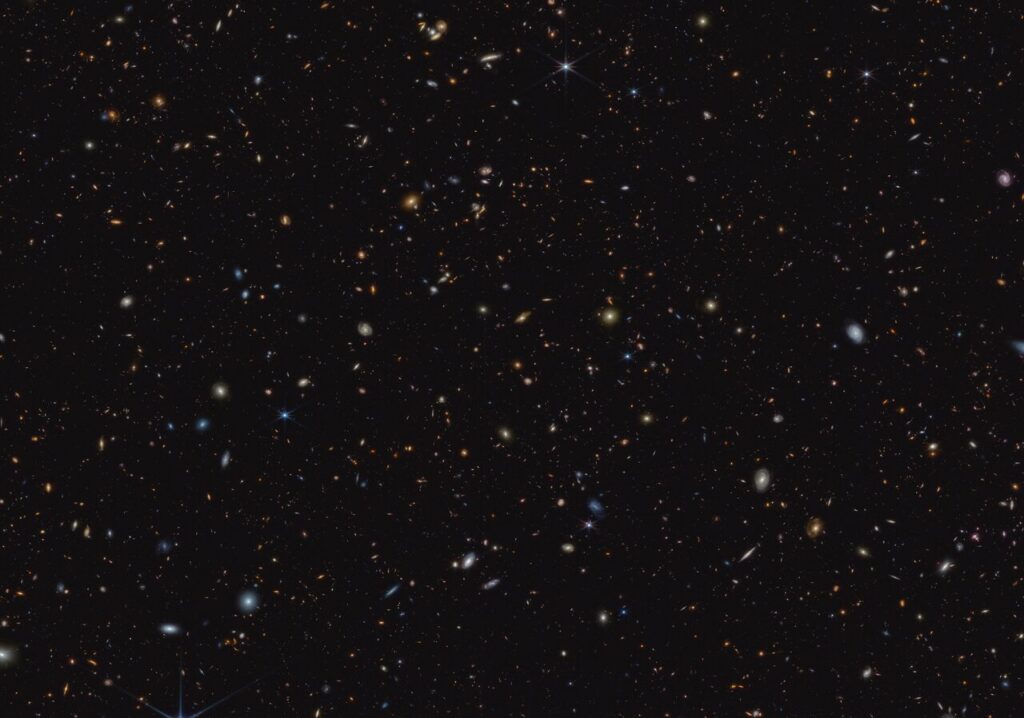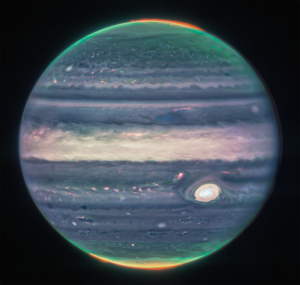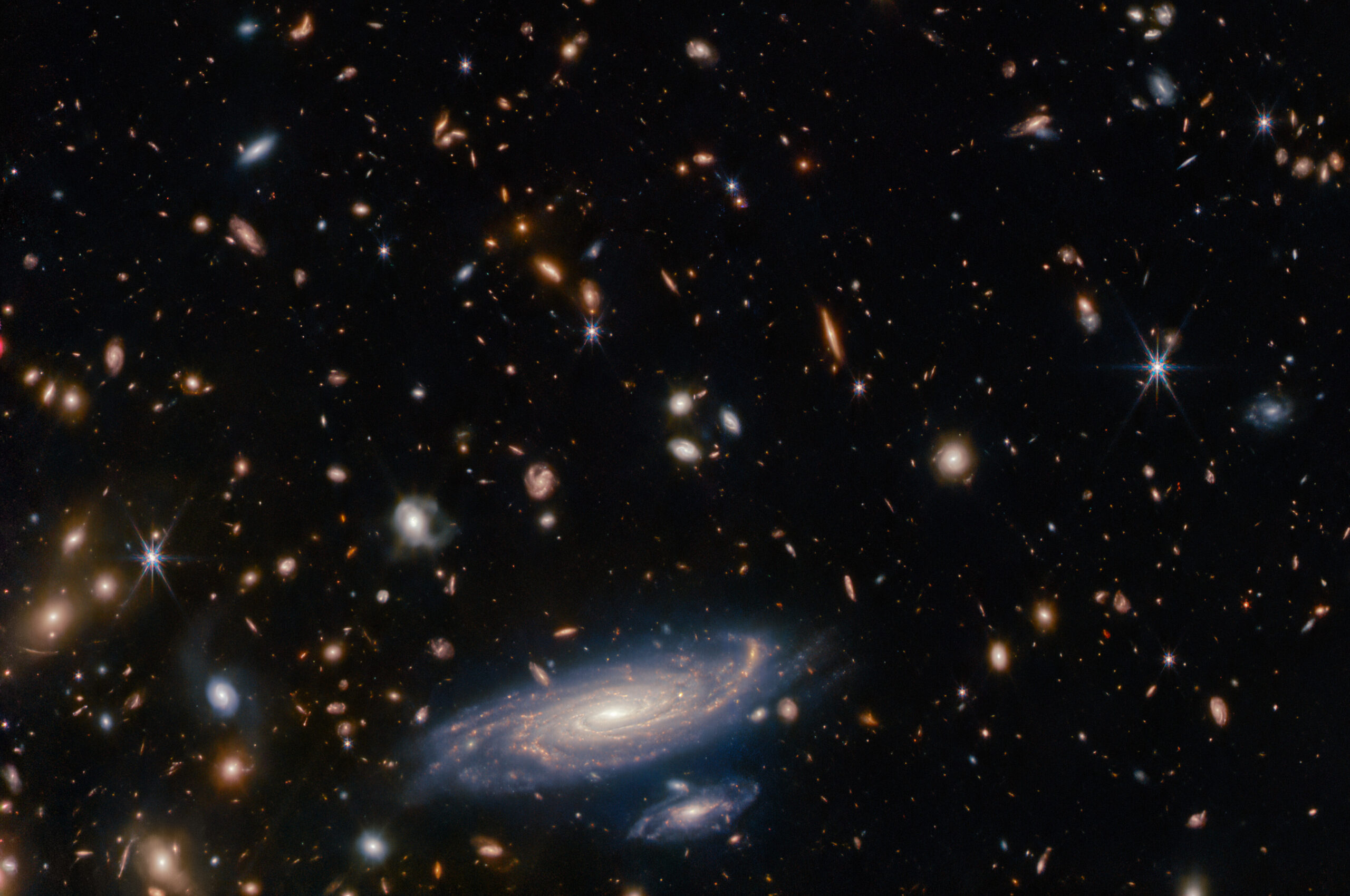Among these was ISSI Team #562 “First Light at Cosmic Dawn: Exploiting the James Webb Space Telescope Revolution”, composed of astrophysicists and computer scientists, who are working on one of the core science goals of JWST: finding the first stars and galaxies in the Universe. Discussions on the insights from the initial months of JWST data during their first meeting led Team #562 and their collaborators to submit three proposals that were awarded 153 hours of observing time with three complementary JWST observing modes.
The first survey (GO-4111; PI Wren Suess) titled “Medium bands, Mega Science: Spatially-resolved R~15 spectrophotometry of 50,000 sources at z=0.3-12” is a NIRCam imaging program that leverages the power of medium-band filters combined with cosmological lensing of the Abell2744 cluster/UNCOVER field to efficiently map both stellar continuum and nebular line emission from ionised gas for large, unbiased galaxy samples. By simultaneously probing multiple emission lines the JWST data will measure star formation and dust obscuration and chart the growth of galaxies across >10 Gyrs of cosmic history.

GOODS-S field (NIRCam image) Credit: NASA, ESA, CSA, B. Robertson (UC Santa Cruz), B. Johnson (Center for Astrophysics, Harvard & Smithsonian), S. Tacchella (University of Cambridge, M. Rieke (Univ. of Arizona), D. Eisenstein (Center for Astrophysics, Harvard & Smithsonian), A. Pagan (STScI)
The second program obtains spectroscopy with the NIRSpec instrument (GO-4233; PIs de Graaff & Brammer) over existing, public JWST fields: “A complete census of the rare, extreme and red: A NIRCam-selected extragalactic community survey with JWST/NIRSpec”. The main goal is to obtain detailed, spectroscopic information for newly identified galaxies from JWST images to reveal their nature, and doing this at high completeness.
The final program is a combination of the previous two. GO-3516 (PIs Matthee & Naidu) uses slitless spectroscopy at ~3-4 micron over the same galaxy cluster as the first program in order to search for faint, metal-poor emission line sources. The title of this program summarizes its goals: “All the Little Things: Pop III Signatures & the Ionizing Photon Budget of Dwarf Galaxies in the Epoch of Reionization”.
With more than an 8:1 oversubscription rate for proposals in these categories, the successes of ISSI Team #562 are particularly noteworthy. Speaking on behalf of their team members team leaders Pascal Oesch and Michael Maseda highlighted: “The ISSI team meeting was instrumental in putting these successful proposals together, and we are very thankful to the whole ISSI team for providing us with this opportunity.” ISSI is particularly pleased that the first of these three proposals is led by early-career researcher (ECR) Wren Suess, whose participation to the ISSI Team meeting was enabled by ISSI’s dedicated ECR funding line.
Freshly approved ISSI Team #23-592 “Jupiter’s non-auroral ionosphere” got off to a flying start of its activities with the award of 22 hours with JWST for project GO-3665 (PIs Stallard & Melin). Studying Jupiter’s equatorial ionosphere in more detail with JWST will further the understanding of energy exchange at the top of the atmosphere, by providing improved constraints for ionospheric models. Atmospheric loss occurs only within this upper region, and so characterising the process on Jupiter provides insight into atmospheric erosion and ultimately thresholds the long term evolution of planets both within and outside our own Solar system.
Determining the vertical structure in the ionosphere away from the bright aurora requires a combination of JWST spectral imaging, utilising the NIRSpec instrument’s integral field spectroscopy mode, and spacecraft occultations of the radio signal from Earth. Via JWST project GO-3665, ISSI Team #23-592 plans to measure the ionospheric structure with JWST simultaneously with the first Juno radio occultations of the Jupiter ionosphere on Sep. 7.
In its first year of science operations, JWST has already demonstrated that it is capable of exceeding expectations and making breakthrough observations in many fields of astrophysics.
Looking ahead to the near future, in March 2024 ISSI will organise a workshop on “The chronology of the 1st billion years”. Outlining her expectations for this workshop, ISSI Executive Director and workshop convenor Antonella Nota, says: “JWST was designed to shed (IR) light on what happened in the early stages of the Universe. Now that most observations from the first JWST cycle have been completed, the time is ripe to convene at ISSI all the cosmology experts with early JWST data, to discuss and distill our current understanding of the formation and early evolution of the first stars and galaxies. At ISSI, we felt that this topic was so important that we are dedicating to it our very first Breakthrough Workshop, a workshop that is aimed at addressing one big question in science” Antonella Nota adds: “ISSI is the perfect place to hold such important conversations, by offering a neutral and welcoming environment, and advancing science – one big question at a time.
The ISSI staff look forward to hosting this workshop and to many further exciting JWST results from the ISSI community.
edited by Mark Sargent



